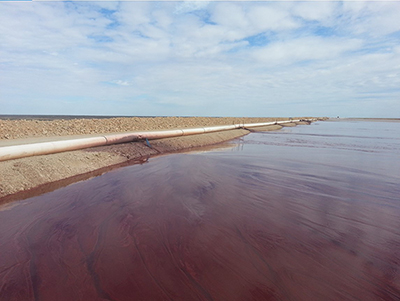
Olympic Dam tailings storage facility. Courtesy of BHP.
The appropriate and responsible management of tailings and tailings storage facilities in South Australia is focused on ensuring safe, stable and economic storage of the mineral wastes produced by mining operations during the mining and processing of mineral ores. Tailings differ from overburden, which is the waste rock or other material that overlies an ore or mineral body and is displaced unprocessed during mining.
Tailings are the mineral waste remaining after the processing of ore to extract mineral concentrates and are typically stored within an engineered containment structure known as a tailing storage facility or TSF. A number of TSFs remain active in South Australia, the largest associated with the Olympic Dam mine near Roxby Downs. Some historic tailings dams date back to the early settlement of South Australia.
Mine operators are required to demonstrate an ability to effectively manage tailings and tailings storage facilities and their inherent risks as part of the comprehensive permitting approvals process that allows mines to operate in South Australia. The major risks posed by tailings dams is leakage from or breach of the engineered containment structure. Facilities are designed, operated, audited and monitored to ensure these and other risks remain negligible.
In South Australia, the management of tailings is required to comply with the provisions of the Mining Act, Environment Protection Act, and wherever relevant, the Radiation Protection and Control Act and the Commonwealth Environment Protection and Biodiversity Conservation Act, and the regulations that derive from this legislation.
Resource companies are expected to follow key principles, standards and requirements to ensure that tailings and their storage presents negligible risks to public and worker health, safety and the environment.
These key principles and requirements are:
- Consideration of economic, environmental and social impacts of tailings and TSF management at all stages of the mine life cycle
- Application of risk-management techniques on a site-specific basis to achieve sound outcomes throughout the life of the mine
- Early, ongoing and effective stakeholder engagement that results in the community and government being satisfied with the processes for tailings and TSF management
- Minimisation of the production of tailings/water content and maximisation of their safe re-use
- Management of TSFs are periodically reviewed to meet the leading practice principles and technology available at that time
- Tailings facilities are designed to meet strict Australian and International Standards, such as guidelines published by the Australian National Committee on Large Dams Inc. (ANCOLD), which has been developed to achieve excellence for all aspects of dam engineering, management and associated issues
- Tailings and TSF design and management is in accordance with any environment authorisation or licence issued by the EPA, the Environment Protection (Water Quality) Policy and the provisions of the relevant program for environment protection and rehabilitation (PEPR)
- All tailings structures are operationally stable, retain their long-term integrity and are able to be rehabilitated
- Rehabilitation of TSFs is achieved consistently with general standards for rehabilitation as set out in the department's Tailings Policy, and the site specific regulatory framework for the site as set out in the relevant lease conditions and PEPR
- Demonstrated capacity and capability of the mine operator to implement the tailings and TSF management plan at all stages of the mine life cycle
- Effective monitoring and reporting on tailings and TSF management practices
Related information
DEM guidance
- Mineral policy 007: Mining Act tailings regulation and standards (PDF 235 KB)
- TOR 005 Metallic and industrial mineral PEPRs (PDF 464 KB)
- TOR 006 Mineral mine lease/licence applications (PDF 505 KB)
- TOR 022: Metallic and industrial mineral transitional PEPRs (PDF 492 KB)
- TOR 025: Change in operations applications (PDF 398 KB)
Legislation
- Mining Act 1971
- Environment Protection Act 1993
- Radiation Protection and Control Act 2021
- Environment Protection and Biodiversity Conservation Act 1999 (Cth)


